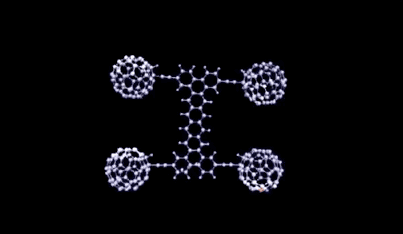
[Image above] Screen capture of a microscopic view of a nanocar from the American Chemical Society Reactions video, “The World’s Smallest Robots: Rise of the Nanomachines.” Credit: American Chemical Society; YouTube
Scientists are racing to build the world’s tiniest super robots—more scientifically known as nanomachines—that could someday do miraculous things on a macro scale, like carry necessary drugs to specific parts of the human body or aid cleanup of environmental disasters.
These microscopic devices are made from molecules that are magnitudes smaller than a human cell. And they can move, change form, or do work on their environment—all thanks to scientists at the helm controlling their chemical and physical properties, according to a recent video from the American Chemical Society’s Reactions online video series.
So far, scientists have successfully created molecular motors, switches, shuttles, turnstiles, and nanocars, the video explains.
Dan Claes, professor in the Department of Physics and Astronomy at the University of Nebraska-Lincoln, lays out the basic science behind the simplest type of molecular machine: nanoswitches.
“Like light switches, molecular switches go on or off. The molecules undergo conformational changes. These are simply changes in structure. They’ve still got all the atoms attached in the same order, but they can bend and twist in response to a stimulus… sort of like a beach chair that you can fold or unfold. By shining UV light, changing temperature, or prompting chemical reactions in other ways, you can force these molecular switches to undergo conformational changes and thus switch on or off,” Claes says in the video.

Credit: American Chemical Society Reactions; YouTube
But other types of nanomachines can get way more complex than simple switches. These tiny-but-powerful machines can be 3-D or DNA-based or they can walk… the list goes on. So scientists are developing molecular machines built from lots of tiny robots working together toward collective motion, which would, in theory, enable nanoscale machines to move things at a macro level—like transporting nano-cargo, such as drugs or information, throughout our bodies and the environment.
Slightly larger (but still microscopic) machines like microrockets and microsubmarines could operate the same way as nanomachines, but carry more cargo, the video explains. These types of machines work by reacting to the environment. For example, microsubmarines could be unleashed after a devastating oil spill to help capture and dispose of harmful oil in the environment through hydrophobic propulsion.
“All of this sounds great, but there are plenty of examples of other technologies that beat out molecular machines on efficiency, speed, and capabilities. These miniature workhorses use much less energy than bigger machines—but we still have to figure out how to take advantage of that before nanobots can work for us,” Claes says in the video.
So how can materials scientists take advantage of nanomachines’ microscopic size (and microscopic energy use to match) to boost efficiency and put them to work for us for longer?
Minimizing friction is a good place to start.
And a group of Italian scientists is working on it. They are developing a new theoretical approach to using fullerene spheres to help reduce friction in nanomachines, according to a paper published in the journal Nanoscale.
“Fullerenes, C60 molecules also known as buckyballs, were shown by computer simulation to slide on the nanoscale, and thus possibly act as ‘nano-bearings’ to help the machines work more efficiently,” according to a MaterialsToday.com article about the study.
This could be a breakthrough way for scientists to better control friction and extend the life of the nanomachine.
The paper, published in Nanoscale, is “Does rotational melting make molecular crystal surfaces more slippery?” (DOI: 10.1039/C4NR04641B).
Author
Stephanie Liverani
CTT Categories
- Electronics
- Manufacturing
- Material Innovations
- Nanomaterials
Spotlight Categories
- Member Highlights


